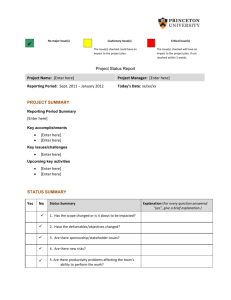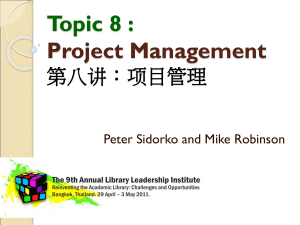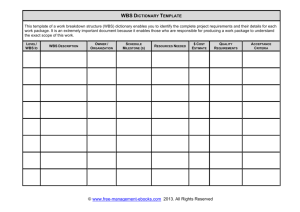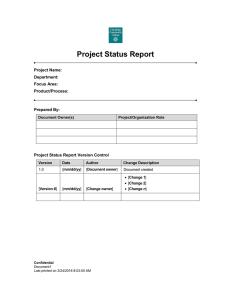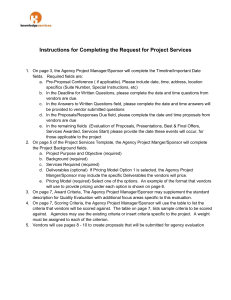documentation
advertisement
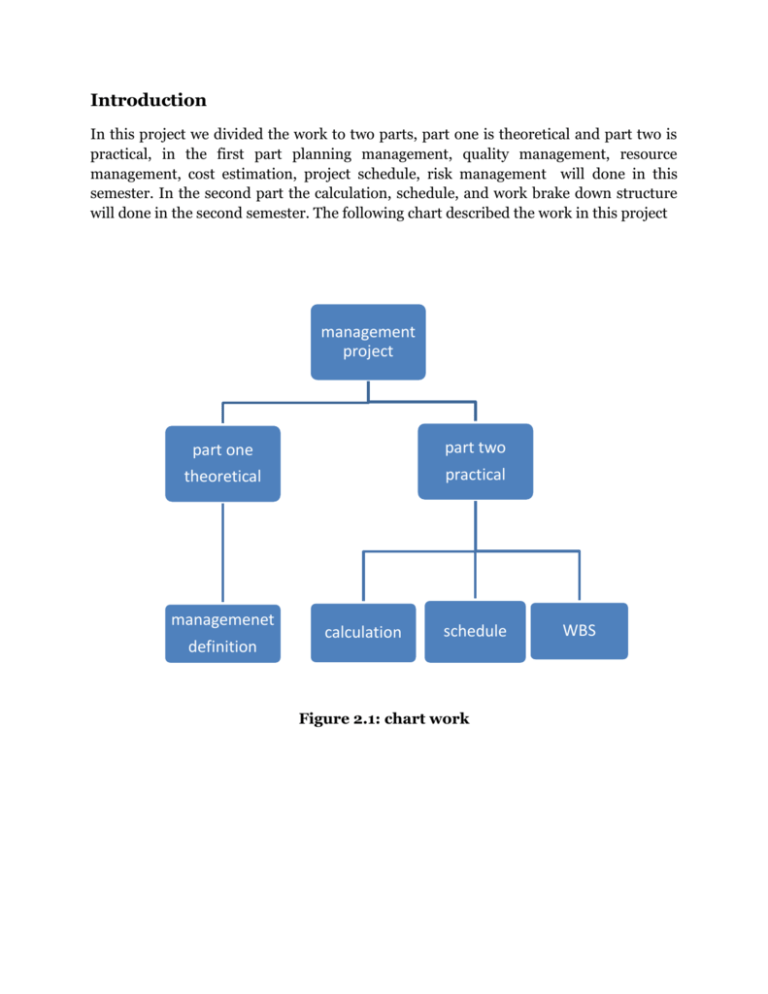
Introduction In this project we divided the work to two parts, part one is theoretical and part two is practical, in the first part planning management, quality management, resource management, cost estimation, project schedule, risk management will done in this semester. In the second part the calculation, schedule, and work brake down structure will done in the second semester. The following chart described the work in this project management project part one part two theoretical practical managemenet definition calculation schedule Figure 2.1: chart work WBS 1: Part one (theoretical) Planning management Project failures caused primarily by poor project management, especially the failure to plan properly. There are two barriers to good planning . The first is prevailing paradigms, and the second is the nature of human beings .A paradigm is a belief about what the is like. It is not necessarily ,what they say they believe, but what they really believe that counts. One of reasons that do not plan is that they find the activity painful. Some individuals, especially engineers and programmers, see concerned that they will hold to estimates of task durations that they have made using their best guesses. Because they have no historical data to draw on ,this is all they can do .However, they also know that such numbers are highly uncertain, and they are afraid that failure to meet established targets will get them in trouble. Another trap that causes people not to plan is to believe that they have no time to plan ;they need to get the job done really fast. We must have a plan that tells where we are supposed to be in the first place If we have no plan, then, we cannot possibly have control. If we do not know where we are ,we cannot have control. In any event , the major point to remember is that we cannot have control , unless we a plan, so planning is not an option. Finally predicting the future is easy. It knows what is going on now that is hard. Quality management During the past twenty years, there has been a revolution toward improved quality. The improvements have occurred not only in product quality, but also in quality leadership and quality project management. Unfortunately, it takes an economic disaster or a recession to get management to recognize the need for improved quality. Prior to the recession of 1979–1982, Ford, General Motors, and Chrysler viewed each other as the competition rather than the Japanese. Prior to the recession of 1989–1994, high-tech engineering companies never fully recognized the need for shortening product development time and the relationship between project management, total quality management, and concurrent engineering. Resource management: as a simple definition all think that the project needs to complete. (Material, Equipment, Manpower, Money, Time). So that every project resources and each activity should be planned considering the budget .and attention to critical resources for project success, (i.e. when a network is developed for a project the logic of network presumably reflects the sequences of the activities as they must take place, without regard to limitation imposed by the availability of resources. In practice this is not typically the case. Invariably, the logic initially incorporated in a net work already reflects the fact that some resources must be efficiently utilized. Cost estimation Approximation of the probable total cost of a product, program, or project, computed on the basis of available information. Four common types of cost estimates are: (1) Planning estimate: rough approximation of cost within a reasonable range of values, prepared for information purposes only. (2) Budget estimate: approximation based on well defined (but preliminary) cost data and established ground rules. (3) Firm estimate: based on cost data sound enough for entering into a binding contract. (4) Notto-exceed /Not-less-than estimate: maximum or minimum amount required to accomplish a given task, based on firm cost estimate. Project schedule A schedule tells you what will be done, by when. Most projects need two different types of schedule: a milestone schedule and deliverable schedule. A milestone schedule is the 10000 foot view of the project schedule. It shows the 10 to 12 major accomplishments for the project, and dates those accomplishments will be completed. The deliverables schedule is the 100 foot view. It shows every deliverable that will be produced. The project consist of a number of tasks and activities, and one of the key planning issues is to decide how long each task will take to complete and the order in which they should take place. Its not enough to decide how long each task will take because some tasks can't be started until other are completed. Scheduling involves decisions about timing and sequence. The full cost of a project, both in financial terms and in staffing effort can't be estimated until the time to complete the full project outcomes is identified. Risk management: risk management is one of the most important areas of project management that must be considered. Companies that want to compete with one another have adopted project management as a method of managing their companies. They have had to learn how to define and control project scope, schedule, and cost as baselines, and they have had to learn all of the control elements necessary to make successful projects. But many of these companies have yet to learn to manage the risks involved in managing a project. 2: Part two (practical) Calculating of all quantity for the school The preparations of this stage were done depending on drawing and details of the drawings and the specifications of this project. The calculations were made according to the materials used and the type of materials to be used .And the Units of the materials. Such as: the concrete was calculated according to its volume (m3), the steel was calculated according to its Length then this length converted to weight (ton), and the block by number. The other calculations were done by m, m2, m3 or lump sum. make schedule for the project The activity duration depend on the productivity of labor and machines . The productivity is defined as the amount of work that can be done per unit time (hour, day, and month) The duration of activity calculated by using the following equation: (Duration = quantity of activity \ productivity) A schedule tells you what will be done, by when. Most projects need two different types of schedule: a milestone schedule and deliverable schedule. The project consist of a number of tasks and activities, and one of the key planning issues is to decide how long each task will take to complete and the order in which they should take place. It's not enough to decide how long each task will take because some tasks can't be started until other are completed. Scheduling involves decisions about timing and sequence. The full cost of a project, both in financial terms and in staffing effort can't be estimated until the time to complete the full project outcomes is identified. how to make (WBDS) As mentioned previously (in part I) the WBS can be done according to the levels that make it easers to make the measurement and controlling the project at best condition. WBS of this project started from the main element which is " optical and nursing college '' as one element and then detailed to smaller elements until reach package unit. The project was divided into four levels which are: 1. 1st level : optical and nursing college 2. 2nd level : earthwork, Civil, finishing, Mechanical and Electrical 3. 3rd level : 3rd basement, 2nd basement, 1st basement …………. 4. 4th level : Activities.
